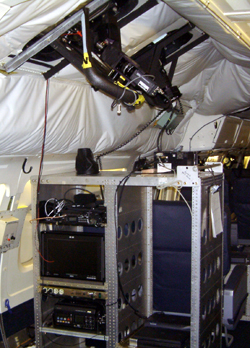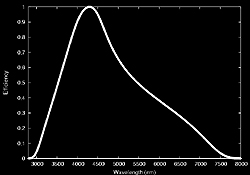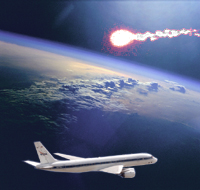|
NUV - Intensified High Definition TV Near-UV Spectrograph
Instrument P.I.: Shinsuke Abe, University of Kobe, Japan.
The information below will be updated as more precise data is received.
Technique: Intensified near-UV slit-less spectroscopy on High Definition TV.
Scientific objective: Measure near-UV emissions of N2+ and CN molecules from air plasma and ablation products.
 Instrument: The instrument consists of an intensified High definition TV camera equipped with a transmission grating with 600 grooves per mm, blazed at 550 nm, made by Jobin Yvon. The camera has a blue sensitive 1-inch 2M-pixel FIT CCD, which has a resolution of 1150 TV lines. A 50 mm f1.0 lens provides a large 37 x 21 degree field of view. No coaligned camera is needed.
Instrument: The instrument consists of an intensified High definition TV camera equipped with a transmission grating with 600 grooves per mm, blazed at 550 nm, made by Jobin Yvon. The camera has a blue sensitive 1-inch 2M-pixel FIT CCD, which has a resolution of 1150 TV lines. A 50 mm f1.0 lens provides a large 37 x 21 degree field of view. No coaligned camera is needed.
Heritage: This camera was deployed during the 2002 Leonid MAC mission in a 60 degree port (see photo). Now camera operated on swivel mount in low window.
Aircraft hardware requirements: Window swivel mount. Rack mounted recorder and control unit. Stow box for camera only. Quartz window.
Instrument validation tests: This camera has been used extensively in past Leonid MAC missions.
Sensitivity: Spectra of meteors as faint as +5 magnitude have been recorded with this instrument.
Dynamic range: 10-bit (factor 1024).
Frame rate and exposure times: Frame rate is 30 frames per second (60 fields per second).
Spectral resolution - gives the FWHM of an instrument-broadened unresolved atomic spectral line:
2.2 nm FWHM in first order.
Relative spectral response - gives the wavelength dependence of the combined system (window, lens, spectrograph, and CCD camera). The Quantum Efficiency of the system depends somewhat on the angle of viewing through the window (window absorption at the near-UV cut-off). Values need to be multiplied by cos(angle), with angle the viewing angle of the camera away from the position of the Sample Return Capsule:

wavelength: Quantum Efficiency:
(nm) (fraction)
320.0 0.002
330.0 0.006
340.0 0.016
350.0 0.040
360.0 0.104
370.0 0.154
380.0 0.178
390.0 0.186
400.0 0.196
410.0 0.198
420.0 0.194
430.0 0.186
440.0 0.174
450.0 0.164
460.0 0.154
470.0 0.140
480.0 0.128
490.0 0.120
500.0 0.114
510.0 0.104
520.0 0.096
530.0 0.092
540.0 0.088
550.0 0.084
560.0 0.082
570.0 0.080
580.0 0.078
590.0 0.076
600.0 0.074
610.0 0.072
620.0 0.070
630.0 0.068
640.0 0.066
650.0 0.064
660.0 0.060
670.0 0.056
680.0 0.052
690.0 0.048
700.0 0.044
710.0 0.040
720.0 0.036
730.0 0.032
740.0 0.028
750.0 0.024
760.0 0.022
770.0 0.020
780.0 0.018
790.0 0.016
800.0 0.015
810.0 0.014
820.0 0.013
830.0 0.012
840.0 0.011
850.0 0.008
860.0 0.002
|










 Instrument: The instrument consists of an intensified High definition TV camera equipped with a transmission grating with 600 grooves per mm, blazed at 550 nm, made by Jobin Yvon. The camera has a blue sensitive 1-inch 2M-pixel FIT CCD, which has a resolution of 1150 TV lines. A 50 mm f1.0 lens provides a large 37 x 21 degree field of view. No coaligned camera is needed.
Instrument: The instrument consists of an intensified High definition TV camera equipped with a transmission grating with 600 grooves per mm, blazed at 550 nm, made by Jobin Yvon. The camera has a blue sensitive 1-inch 2M-pixel FIT CCD, which has a resolution of 1150 TV lines. A 50 mm f1.0 lens provides a large 37 x 21 degree field of view. No coaligned camera is needed.
